4 Comments
If you or your child is starting piano lessons, but you are unsure of the commitment level or you don’t want to break the bank with a piano purchase, you will probably start looking at digital pianos that have enough features to be an adequate alternative to an acoustic upright or grand piano. In this article, I will talk about the comparably priced, three most popular beginner digital pianos that we use for lessons or offer as rental or loaner pianos to our students, the Yamaha DGX 640, Privia PX-130, and Yamaha P95S. 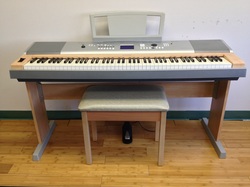 The Yamaha DGX-640 The newest release of the DGX series (also known as YPG) is the DGX-640. These models look alike from the DGX-620 through the DGX-640, and there have been minor improvements along the way, though the most notable would be moving from 32 note polyphony in the 620 to 64 note polyphony in the 640. Higher polyphony, which is simply the number of notes that can be sustained at one time, becomes more important as the student progresses and plays more complicated passages where there is risk of sustained notes “falling off”. The newer DGX series also has the option of adding a three pedal board instead of a single free standing pedal. As far as the touch and feel, Yamaha is one of the best at quality hammer action and great stereo sampled grand piano sounds. Finally, there are a number of features and gadgets that the other pianos don’t have. The ability to layer multiple tracks for one, is something that a composer would want. The appearance is a bit keyboardy, but this digital piano is often the choice of universities and music lessons studios as the preferred practice model because of it’s durability 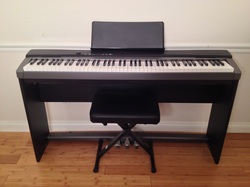 The Casio Privia PX-130 This piano has been the feather in the cap for Casio and this model is one of our most popular rental pianos. It boasts a sleek elegant black case with silver pedals (optional) and offers great sounds, touch and 128 note polyphony, which is more than anyone would ever need. Based on appearances, this would be the best choice of the three models reviewed in this article. The PX-130 is a major redesign from the previous models, the PX-120, PX-110, and PX-100. Casio cleverly uses the keys as feature controls rather than a litany of buttons. There is question as to how this piano will hold up in 5-10 years compared to the others. Casio pianos tend to get a bit of a plasticky touch to the keys when they get older, more so than the Yamahas. 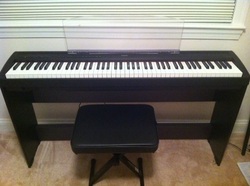 Yamaha P95S Like the PX-130, the Yamaha P95S is a sleek, good looking digital piano that is great for beginners. If you like the touch of a Yamaha, then you will want to select this over the Privia, and if you just want piano features without a bunch of extra gadgets, then you will want to choose this over the DGX series. The max polyphony is 64 notes at one time, which is more than adequate for the beginner. I would have liked to see a solid colored music rest rather than the clear plastic one, but this is just my personal preference. The optional three pedal board has plastic pedals which don’t look as nice as the Privia’s pedals, but they work well and seem more durable.. I’d have to give a slight edge to the graded hammer touch of the P95S over the Privia. The shell of the piano also seems more durable. In the world of beginner pianos, there are so many models to choose from. We think these three are the best and they are certainly our most requested models. I’m happy to answer any questions about these or other models if you’d like to email me at [email protected] Should you buy a Piano or Digital Piano? I will give you a high level overview of what to consider when making this decision. Usually people make this decision based on their budget, living arrangements, commitment/level of proficiency or some combination of all of these factors. This will be a three part blog focusing on each of these factors. This post will focus on the budget aspect.
Generally speaking, a digital piano is a less expensive option than an acoustic upright or grand piano, though you will often see free upright pianos being given away on craigslist. I would stay away from those unless you know what you are doing. They can easily be a bigger project than you might think when you consider moving expenses, tuning (can it even hold a pitch), brand, quality, etc. There are many digital pianos, however, that are more expensive than an acoustic piano, but for the purposes of this blog, I will use basic uprights and basic fully weighted 88-key digitals as the benchmarks. Whichever you end up buying, I would suggest that you stick to a well known brand so that if you do need to sell in the future, your piano will experience less depreciation. If acoustic, Yamaha and Kawai hold their value the best. Yes you will spend more, but 30 years from now, people will still want that piano. Lesser known brands will be give-a-ways at that age. Always buy a black piano. Brown ones do not hold their value like black ones do. The majority of people shopping are looking for a black piano because it goes with everything. If you are buying a digital piano, again, I would stick with the best brands. Yamaha Clavinova or YDP series, Roland, Kawai, and believe it or not, Casio has come up with a fantastic digital piano line with the Privia. There are so many brands like Williams, Suzuki and others that will fall apart quickly. Color is less important with digital pianos, but typically dark brown or black are the most desired. If buying a used digital piano for sale, test the keys and make sure they all have an even consistent sound and feel. Listen for “press and release” noise. This should be very quiet so it is not distracting to the player. Make sure the pedals work. Turn it off and on again to make sure the electronics are working properly. Age is important, but anything post 1998 should be adequate because by then, almost all electronic pianos made the change from analog sounds to sampled grand piano sounds, and there has been somewhat of a plateau since then. Renting a digital piano for a beginner is not a bad idea to save money if the player loses interest, or if they have a high level of interest, you may want to purchase an acoustic piano or more advanced digital piano. Piano rental allows you to defer that decision to a later date. If buying a used acoustic piano, check the age by serial number if you can find a source. Yamaha and Kawai post their serial numbers online so you can tell the age. Don’t be afraid of age if the piano is well maintained or rebuilt, particularly if it is a Yamaha or Kawai. Watch for “grey market” pianos. While there is nothing specifically wrong with these pianos, they were not built for the American market, so may have less value when you go to sell. Do not take on a free piano project unless you know what you are doing. I am happy to answer specific questions about models and prices. Just contact us at [email protected] Singing Strings rents and leases pianos and digital pianos to Northern Virginia, Washington DC, and Maryland, including Baltimore. 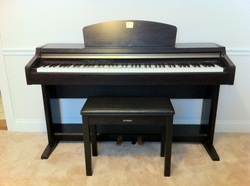 Do you hear a knocking noise or clicking noise when you release the keys on your Clavinova piano? Are you having trouble coming up with a word to describe the sound? You are not alone. Many Clavinova's develop this problem after a few years, and it continues to get worse unless addressed. Why does it do this? inside frame of the digital piano, there are pins that effectively counter weights so that when you press down on the keys, you get the sense that you are pushing real piano keys down, and when you release the key, the counterweight falls back to its original position. Underneath the counterweight is a long stopper pad, or what I call a felt strip, that deadens the sound when the keys are released. Over time through use, and just simple gravity when not used, this felt strip begins to flatten and the effectiveness of the sound deadening begins to fail. How Do I fix it? There are a couple ways to fix this issue. The recommended way is to take it to the shop and get them to replace the lower stopper pad, which could be expensive depending on your options for keyboard repair shops. They will take it apart, order the parts, and it will feel and sound much like a new keyboard when you get it back. The do it yourself way, which I have seen done - sometimes well and sometimes disastrously, is to use thin weatherstripping under the counterweights. To do this, you would need to buy the thinnest 1/4 inch self adhesive weather stripping and cut it into small pieces to stick on the felt under the keys. If you try to stick them to the side, then over time, they will get pushed down,and the self adhesive will begin to stick to the counterweights and you will have a new problem. Feel free to contact me for additional support on this issue or contact us if you are in the DC Area and need a repair by visiting http://www.pianorentaldc.com/clavinova-repairs.html |
About UsSinging Strings Music Center is located in Archives
January 2013
Categories
All
|
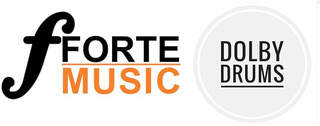
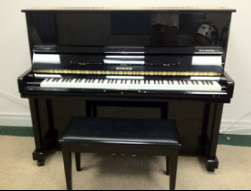
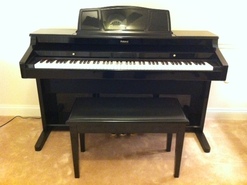
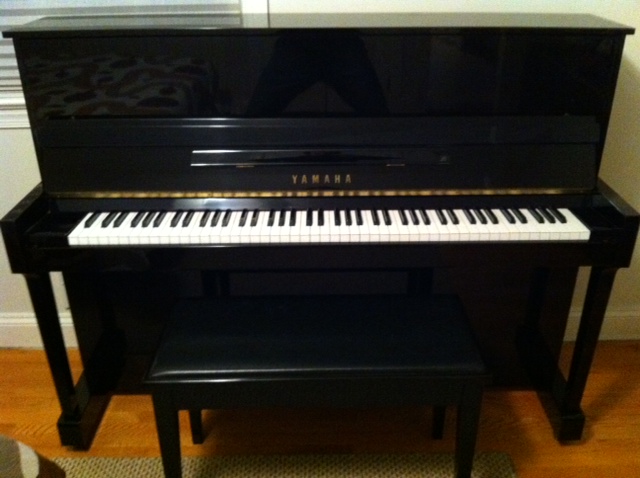
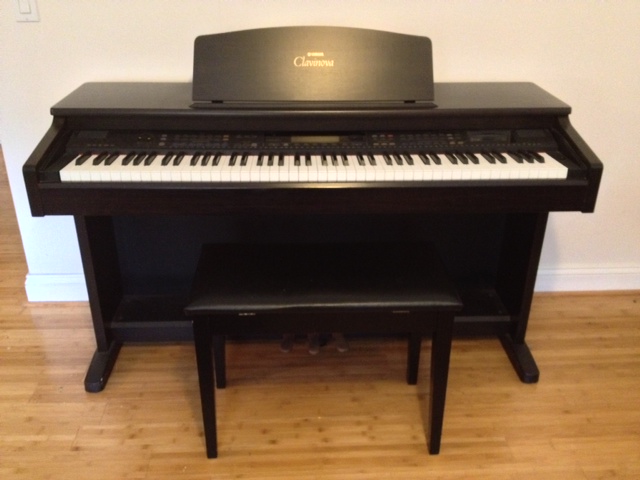
 RSS Feed
RSS Feed